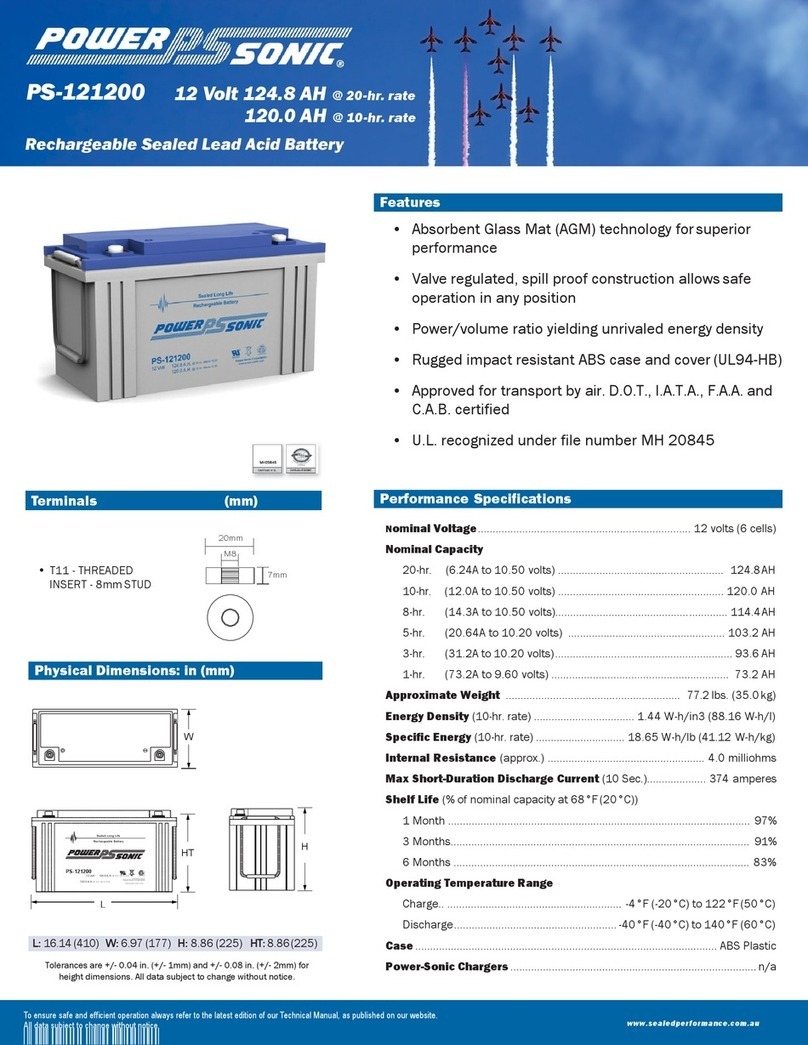@ 0.05C rate @0.1C rate @0.2C rate @0.5C rate @1C rate @2C rate @3C rate
Rated (20 Hr. Rate.) (9 Hr. Rate) (4 Hr. Rate) (1.3 Hr. Rate) (33 Min. Rate) (12 Min. Rate) (7.2 Min. Rate)
Capacity Current Capacity Current Capacity Current Capacity Current Capacity Current Capacity Current Capacity Current Capacity
Amps. Amp. Hrs Amps. Amp. hrs. Amps. Amp.Hrs Amps. Amp. Hrs. Amps. Amp. hrs. Amps. Amp. Hrs. Amps. Amp. Hrs.
0.5AH 0.025 0.50 0.05 0.45 0.10 0.40 0.25 0.325 0.50 0.28 1.00 0.20 1.50 0.18
0.8AH 0.04 0.80 0.08 0.72 0.16 0.64 0.40 0.52 0.80 0.44 1.60 0.32 2.40 0.29
1.0AH 0.05 1.00 0.10 0.90 0.20 0.80 0.50 0.65 1.00 0.56 2.00 0.40 3.00 0.36
1.3AH 0.065 1.30 0.13 1.17 0.26 1.04 0.65 0.845 1.30 0.715 2.60 0.52 3.90 0.47
2.3AH 0.115 2.30 0.23 2.07 0.46 1.84 1.15 1.495 2.30 1.288 4.60 0.92 6.90 0.83
3.0AH 0.15 3.00 0.30 2.70 0.60 2.40 1.50 1.95 3.00 1.65 6.00 1.20 9.00 1.08
3.2AH 0.16 3.20 0.32 2.88 0.64 2.56 1.60 2.08 3.20 1.76 6.40 1.28 9.60 1.15
4.5AH 0.22 4.40 0.45 4.05 0.90 3.60 2.25 2.92 4.5 2.47 9.00 1.80 13.50 1.62
5.0AH 0.25 5.00 0.50 4.50 1.00 4.00 2.50 3.25 5.00 2.80 10.00 2.00 15.00 1.80
6.5AH 0.325 6.50 0.65 5.85 1.30 5.20 3.25 4.23 6.50 3.64 13.00 2.60 19.50 2.34
7.0AH 0.35 7.00 0.70 6.30 1.40 5.60 3.50 4.55 7.00 3.85 14.00 2.80 21.00 2.52
8.0AH 0.40 8.00 0.80 7.20 1.60 6.40 4.00 5.20 8.00 4.48 16.00 3.20 24.00 2.88
9.0AH 0.45 9.00 0.90 8.10 1.80 7.20 4.50 5.85 9.00 5.04 18.00 3.60 27.00 3.24
10.0AH 0.50 10.00 1.00 9.00 2.00 8.00 5.00 6.50 10.00 5.60 20.00 4.00 30.00 3.60
12.0AH 0.60 12.00 1.20 10.80 2.40 9.60 6.00 7.80 12.00 6.72 24.00 4.80 36.00 4.32
18.0AH 0.90 18.00 1.80 16.20 3.06 14.40 9.00 11.70 18.00 9.90 36.00 7.20 54.00 6.48
20.0AH 1.00 20.00 2.00 18.00 4.00 16.00 10.00 13.00 20.00 11.20 40.00 8.00 60.00 7.20
26.0AH 1.30 26.00 2.60 23.40 5.20 20.80 13.00 16.90 26.00 14.30 52.00 10.40 78.00 9.36
28.0AH 1.40 28.00 2.80 25.20 5.40 21.60 14.00 18.20 28.00 15.40 54.00 10.88 84.00 10.08
33.0AH 1.65 33.00 3.30 29.70 6.60 26.40 16.50 21.45 33.00 18.15 66.00 13.20 99.00 11.88
40.0AH 2.00 40.00 4.00 36.00 8.00 32.00 20.00 26.00 40.00 22.40 80.00 16.00 120.00 14.40
55.0AH 2.75 55.00 5.50 49.50 11.00 44.00 27.50 35.75 55.00 30.25 110.00 22.00 165.00 19.80
60.0AH 3.00 60.00 6.00 54.00 12.00 48.00 30.00 39.00 60.00 33.60 120.00 24.00 180.00 21.60
75.0AH 3.75 75.00 7.50 67.50 15.00 60.00 37.50 48.75 75.00 41.25 150.00 30.00 225.00 27.00
80.0AH 4.00 80.00 8.00 72.00 16.00 64.00 40.00 52.00 80.00 44.80 160.00 32.00 240.00 28.80
100.0 AH 5.00 100.00 10.00 90.00 20.00 80.00 50.00 65.00 100.00 55.00 200.00 40.00 300.00 36.00
The capacity of a battery is the total amount of electrical
energy available from a fully charged cell or cells. Its
value depends on the discharge current, the temperature
during discharge, the final (cut-off) voltage and the gen-
eral history of the battery.
Capacity, expressed in ampere-hours (AH) is the product
of the current discharged and the length of discharge
time. The rated capacity (C) of a Power-Sonic battery is
measured by its performance over 20 hours of constant
current discharge at a temperature of 68°F (20°C) to a
cutoff voltage of 1.75 volts.
As an example, Model PS-610, with a rated capacity of
1AH will deliver 50 mA (1/20 of 1AH, or 0.05C ) for 20
hours before the voltage drops from 6.45 to 5.25 volts.
By cycling the battery a few times or float charging it for
a month or two, the highest level of capacity develop-
ment is achieved. Power-Sonic batteries are fully charged
before leaving the factory, but full capacity is realized
only after the battery has been cycled a few times or been
on float charge for some time.
The table in Figure 2 shows capacities for various multi-
ples of the 20-hour discharge current.
CAPACITY
Figure 2
When a battery discharges at a constant rate, its capacity
changes according to the amperage load. Capacity
increases when the discharge current is less than the 20-
hour rate and decreases when the current is higher.
Figure 3 shows capacity curves for major Power-Sonic battery
models with different ampere-hour ratings. Amperage is on the
horizontal scale and the time elapsed is on the vertical scale; the
product of these values is the capacity.
Proper battery selection for a specific application can be
made from this graph if the required time and current are
known. For example, to determine the proper capacity of
a battery providing 3 amps for 20 minutes, locate the
intersection of these values on the graph. The curve
immediately above that point represents the battery
which will meet the requirement.
3




























